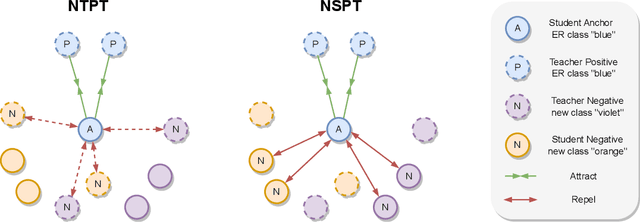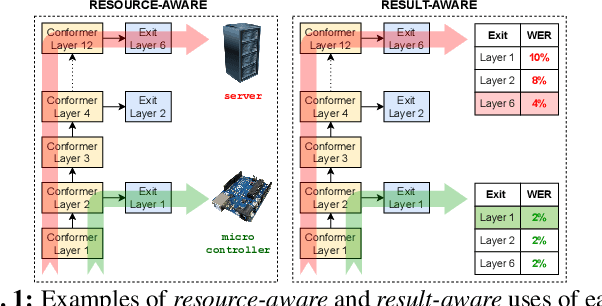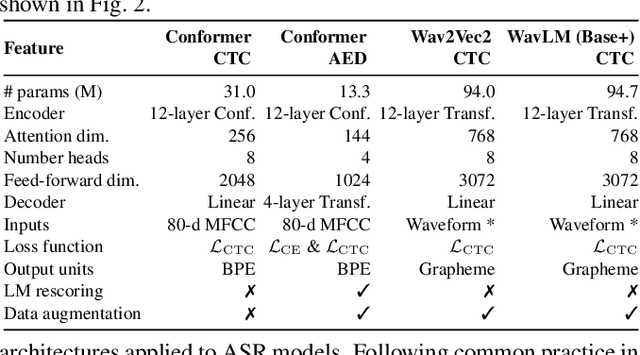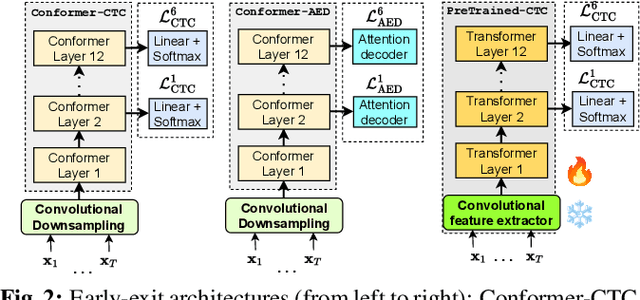Umberto Cappellazzo
Scaling and Enhancing LLM-based AVSR: A Sparse Mixture of Projectors Approach
May 21, 2025Abstract:Audio-Visual Speech Recognition (AVSR) enhances robustness in noisy environments by integrating visual cues. While recent advances integrate Large Language Models (LLMs) into AVSR, their high computational cost hinders deployment in resource-constrained settings. To address this, we propose Llama-SMoP, an efficient Multimodal LLM that employs a Sparse Mixture of Projectors (SMoP) module to scale model capacity without increasing inference costs. By incorporating sparsely-gated mixture-of-experts (MoE) projectors, Llama-SMoP enables the use of smaller LLMs while maintaining strong performance. We explore three SMoP configurations and show that Llama-SMoP DEDR (Disjoint-Experts, Disjoint-Routers), which uses modality-specific routers and experts, achieves superior performance on ASR, VSR, and AVSR tasks. Ablation studies confirm its effectiveness in expert activation, scalability, and noise robustness.
Adaptive Audio-Visual Speech Recognition via Matryoshka-Based Multimodal LLMs
Mar 09, 2025Abstract:Audio-Visual Speech Recognition (AVSR) leverages both audio and visual modalities to enhance speech recognition robustness, particularly in noisy environments. Recent advancements in Large Language Models (LLMs) have demonstrated their effectiveness in speech recognition, including AVSR. However, due to the significant length of speech representations, direct integration with LLMs imposes substantial computational costs. Prior approaches address this by compressing speech representations before feeding them into LLMs. However, higher compression ratios often lead to performance degradation, necessitating a trade-off between computational efficiency and recognition accuracy. To address this challenge, we propose Llama-MTSK, the first Matryoshka-based Multimodal LLM for AVSR, which enables flexible adaptation of the audio-visual token allocation based on specific computational constraints while preserving high performance. Our approach, inspired by Matryoshka Representation Learning, encodes audio-visual representations at multiple granularities within a single model, eliminating the need to train separate models for different compression levels. Moreover, to efficiently fine-tune the LLM, we introduce three LoRA-based Matryoshka strategies using global and scale-specific LoRA modules. Extensive evaluations on the two largest AVSR datasets demonstrate that Llama-MTSK achieves state-of-the-art results, matching or surpassing models trained independently at fixed compression levels.
Evaluating and Improving Continual Learning in Spoken Language Understanding
Feb 16, 2024Abstract:Continual learning has emerged as an increasingly important challenge across various tasks, including Spoken Language Understanding (SLU). In SLU, its objective is to effectively handle the emergence of new concepts and evolving environments. The evaluation of continual learning algorithms typically involves assessing the model's stability, plasticity, and generalizability as fundamental aspects of standards. However, existing continual learning metrics primarily focus on only one or two of the properties. They neglect the overall performance across all tasks, and do not adequately disentangle the plasticity versus stability/generalizability trade-offs within the model. In this work, we propose an evaluation methodology that provides a unified evaluation on stability, plasticity, and generalizability in continual learning. By employing the proposed metric, we demonstrate how introducing various knowledge distillations can improve different aspects of these three properties of the SLU model. We further show that our proposed metric is more sensitive in capturing the impact of task ordering in continual learning, making it better suited for practical use-case scenarios.
Efficient Fine-tuning of Audio Spectrogram Transformers via Soft Mixture of Adapters
Feb 01, 2024Abstract:Mixture of Experts (MoE) architectures have recently started burgeoning due to their ability to scale model's capacity while maintaining the computational cost affordable. Furthermore, they can be applied to both Transformers and State Space Models, the current state-of-the-art models in numerous fields. While MoE has been mostly investigated for the pre-training stage, its use in parameter-efficient transfer learning settings is under-explored. To narrow this gap, this paper attempts to demystify the use of MoE for parameter-efficient fine-tuning of Audio Spectrogram Transformers to audio and speech downstream tasks. Specifically, we propose Soft Mixture of Adapters (Soft-MoA). It exploits adapters as the experts and, leveraging the recent Soft MoE method, it relies on a soft assignment between the input tokens and experts to keep the computational time limited. Extensive experiments across 4 benchmarks demonstrate that Soft-MoA outperforms the single adapter method and performs on par with the dense MoA counterpart. We finally present ablation studies on key elements of Soft-MoA, showing for example that Soft-MoA achieves better scaling with more experts, as well as ensuring that all experts contribute to the computation of the output tokens, thus dispensing with the expert imbalance issue.
Parameter-Efficient Transfer Learning of Audio Spectrogram Transformers
Dec 07, 2023Abstract:The common modus operandi of fine-tuning large pre-trained Transformer models entails the adaptation of all their parameters (i.e., full fine-tuning). While achieving striking results on multiple tasks, this approach becomes unfeasible as the model size and the number of downstream tasks increase. In natural language processing and computer vision, parameter-efficient approaches like prompt-tuning and adapters have emerged as solid alternatives by fine-tuning only a small number of extra parameters, without sacrificing performance accuracy. Specifically, adapters, due to their flexibility, have recently garnered significant attention, leading to several variants. For audio classification tasks, the Audio Spectrogram Transformer model shows impressive results. However, surprisingly, how to efficiently adapt it to several downstream tasks has not been tackled before. In this paper, we bridge this gap and present a detailed investigation of common parameter-efficient methods, revealing that adapters consistently outperform the other methods across four benchmarks. This trend is also confirmed in few-shot learning settings and when the total number of trainable parameters increases, demonstrating adapters superior scalability. We finally study the best adapter configuration, as well as the role of residual connections in the learning process.
Continual Contrastive Spoken Language Understanding
Oct 04, 2023



Abstract:Recently, neural networks have shown impressive progress across diverse fields, with speech processing being no exception. However, recent breakthroughs in this area require extensive offline training using large datasets and tremendous computing resources. Unfortunately, these models struggle to retain their previously acquired knowledge when learning new tasks continually, and retraining from scratch is almost always impractical. In this paper, we investigate the problem of learning sequence-to-sequence models for spoken language understanding in a class-incremental learning (CIL) setting and we propose COCONUT, a CIL method that relies on the combination of experience replay and contrastive learning. Through a modified version of the standard supervised contrastive loss applied only to the rehearsal samples, COCONUT preserves the learned representations by pulling closer samples from the same class and pushing away the others. Moreover, we leverage a multimodal contrastive loss that helps the model learn more discriminative representations of the new data by aligning audio and text features. We also investigate different contrastive designs to combine the strengths of the contrastive loss with teacher-student architectures used for distillation. Experiments on two established SLU datasets reveal the effectiveness of our proposed approach and significant improvements over the baselines. We also show that COCONUT can be combined with methods that operate on the decoder side of the model, resulting in further metrics improvements.
Training dynamic models using early exits for automatic speech recognition on resource-constrained devices
Sep 18, 2023



Abstract:The possibility of dynamically modifying the computational load of neural models at inference time is crucial for on-device processing, where computational power is limited and time-varying. Established approaches for neural model compression exist, but they provide architecturally static models. In this paper, we investigate the use of early-exit architectures, that rely on intermediate exit branches, applied to large-vocabulary speech recognition. This allows for the development of dynamic models that adjust their computational cost to the available resources and recognition performance. Unlike previous works, besides using pre-trained backbones we also train the model from scratch with an early-exit architecture. Experiments on public datasets show that early-exit architectures from scratch not only preserve performance levels when using fewer encoder layers, but also improve task accuracy as compared to using single-exit models or using pre-trained models. Additionally, we investigate an exit selection strategy based on posterior probabilities as an alternative to frame-based entropy.
Sequence-Level Knowledge Distillation for Class-Incremental End-to-End Spoken Language Understanding
May 23, 2023Abstract:The ability to learn new concepts sequentially is a major weakness for modern neural networks, which hinders their use in non-stationary environments. Their propensity to fit the current data distribution to the detriment of the past acquired knowledge leads to the catastrophic forgetting issue. In this work we tackle the problem of Spoken Language Understanding applied to a continual learning setting. We first define a class-incremental scenario for the SLURP dataset. Then, we propose three knowledge distillation (KD) approaches to mitigate forgetting for a sequence-to-sequence transformer model: the first KD method is applied to the encoder output (audio-KD), and the other two work on the decoder output, either directly on the token-level (tok-KD) or on the sequence-level (seq-KD) distributions. We show that the seq-KD substantially improves all the performance metrics, and its combination with the audio-KD further decreases the average WER and enhances the entity prediction metric.
Exploring the Joint Use of Rehearsal and Knowledge Distillation in Continual Learning for Spoken Language Understanding
Nov 15, 2022Abstract:Continual learning refers to a dynamical framework in which a model or agent receives a stream of non-stationary data over time and must adapt to new data while preserving previously acquired knowledge. Unfortunately, deep neural networks fail to meet these two desiderata, incurring the so-called catastrophic forgetting phenomenon. Whereas a vast array of strategies have been proposed to attenuate forgetting in the computer vision domain, for speech-related tasks, on the other hand, there is a dearth of works. In this paper, we turn our attention toward the joint use of rehearsal and knowledge distillation (KD) approaches for spoken language understanding under a class-incremental learning scenario. We report on multiple KD combinations at different levels in the network, showing that combining feature-level and predictions-level KDs leads to the best results. Finally, we provide an ablation study on the effect of the size of the rehearsal memory that corroborates the appropriateness of our approach for low-resource devices.
 Add to Chrome
Add to Chrome Add to Firefox
Add to Firefox Add to Edge
Add to Edge